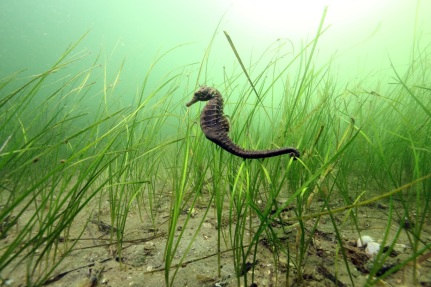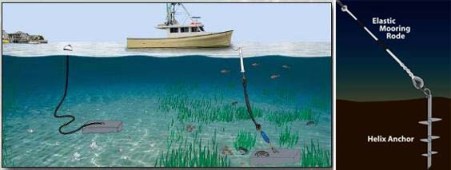Eelgrass (Zostera marina on the U.S. east coast) is a flowering plant that grows submerged in salt water. In other words, it is not a “seaweed,” which are macrophytic algae. Eelgrass is descended from land plant that found a new niche by growing underwater in bays and estuaries where the bottom is shallow enough that a rooted plant can get enough sunlight to survive.
 Eelgrass beds on the east coast of the United States have expanded and contracted through recorded history. They are in decline in many places right now because increased development along the coast has led to nutrient loading in shallow marine environments.
Eelgrass beds on the east coast of the United States have expanded and contracted through recorded history. They are in decline in many places right now because increased development along the coast has led to nutrient loading in shallow marine environments.
Nitrogen is available in usable form in very limited amounts in the natural environment, so photosynthesizing organisms — higher plants, algae, and bacteria — are adapted to this limitation to their growth. Septic systems and fertilizers introduce relatively large amounts of nitrogen (and phosphorus) to the adjacent marine setting. Algae reacts very quickly to the elevated nitrogen levels and “blooms.” These mats of algae block the sunlight and make it difficult for eelgrass to photosynthesize.
Eelgrass has other challenges, including scouring of the seafloor by mooring chains and churning of the water column by boat propellers. Moorings are kept in place by weights and attached to the floats at the surface by chains. At lower tides the extra length of chain drags around the bottom in a circle around the weight, tearing up eelgrass by the roots. Motorboats that drive through eelgrass beds slice through the submerged and floating foliage of the plants.
These are monoecious plants — there are male and female flowers on the same plant — with long narrow leaves. The leaves are 1.2 cm wide and a meter long. The plant reproduces vegetatively via rhizomes and also when pieces of the plant break off and settle elsewhere. It also reproduces sexually by producing seeds that are dispersed by currents. As a result of the vegetative reproduction eelgrass can form extensive beds that are sometimes centuries old. It is a perennial, so the entire plant is present throughout the year.

Because eelgrass beds are both extensive and present year round they have become important habitat for other life forms, including bay scallops, immature cod and mature flounder, crabs, and green algae that grow on the higher plants. Many other animals depend on eelgrass for food, including brant, isopods, and sea urchins.
In the early 1930s elevated temperatures in shallow marine environments on both the east and west coasts of the Atlantic Ocean caused an outbreak of mold that decimated eelgrass beds. In places like Buzzards Bay, Mass. the beds did not recover until the early 1960s. In Barnegat Bay, N.J. the disappearance of the eelgrass beds ends a local industry that harvested the plants to use them to insulate homes.
In addition to natural challenges, since the 1950s nitrogen loading has caused eelgrass to disappear in many locations. In Chesapeake Bay there is an effort underway to actively replant eelgrass rather than waiting for it to recover naturally.

On Martha’s Vineyard the National Oceanic and Atmospheric Administration (NOAA) is teaming up with the Town of Tisbury to finance the introduction of “conservation moorings.” The chains on traditional moorings are replaced by floating plastic tubes that do not scour the bottom. The town has also passed a local law that requires property owners in the watersheds of Lake Tashmoo and the Lagoon Pond to install advanced septic systems that cut down on the amount of nitrogen leaching from the adjacent substrate into the nearby estuaries.
Once eelgrass is lost in an area, it is difficult to reestablish it if there is regular boat activity and if the surface water is regularly made turbulent by wind and tidal currents. All this energy causes the resuspension of fine bottom sediments that are no longer held in place by the eelgrass roots (and the water is no longer calmed by the dense eelgrass foliage). The suspended sediment shades the bottom and makes it difficult for eelgrass to grow.
